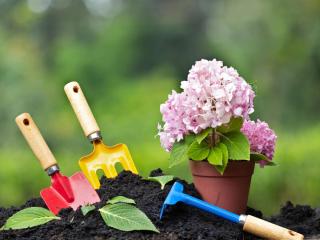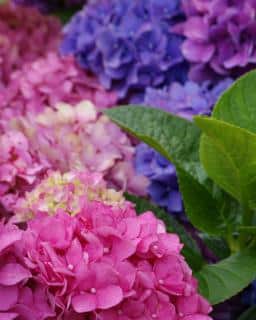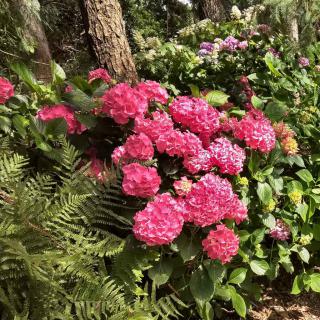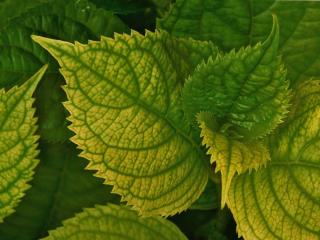

Hydrangea is without doubt a beautiful flower-bearing plant.
Key Hydrangea facts
Name – Hydrangea
Family – Hydrangeaceae
Type – shrub
Height – 3 to 6 ½ feet (1 to 2 meters)
Exposure – part sun and shade
Soil: soil with heath – Foliage: deciduous – Flowering: end of spring → fall
Easy to grow and to care for, hydrangeas are amazing all summer long with their magnificent flowers in hues from pink to blue. Moreover, it’s one of very few shrubs that thrive in full shade!
Hydrangeas are best planted in fall. Heath-amended soil is mandatory for this plant, especially if your soil is otherwise chalky.
 Choosing a partly shaded spot is enough to guarantee magnificent flowers and give your shrub the best it needs to develop harmoniously.
Choosing a partly shaded spot is enough to guarantee magnificent flowers and give your shrub the best it needs to develop harmoniously.
For plants that have been purchased in pots or containers, it’s possible to transplant until spring and even summer as long as both hot and cold spells are avoided.
If you are hoping to see your plants grow large and wide, plant them 30 to 40 inches (80 to 100 cm) apart.
 At the end of winter, it’s possible to purchase hydrangea in pots. Their beautiful blooms will decorate your home.
At the end of winter, it’s possible to purchase hydrangea in pots. Their beautiful blooms will decorate your home.
 Even though hydrangeas are very easy to care for and practically don’t need any attention, an annual pruning will significantly boost blooming.
Even though hydrangeas are very easy to care for and practically don’t need any attention, an annual pruning will significantly boost blooming.
Good idea: keep a few flowers on the shrub; they’ll dry out and make fantastic dried-flower bouquets for Christmas.
Master Gardener in the renowned Valloires Gardens, in France
Hydrangeas are rather sturdy, but there are a few weak points that open the door to diseases.
If white balls appear along the stems, you are certainly facing an invasion of hydrangea scale insects.
If whitish felt covers the underside of leaves, it is surely an attack of powdery mildew.
 If your soil is too chalky or alkaline, your hydrangea may sag and show signs of exhaustion, and leaves will turn yellow.
If your soil is too chalky or alkaline, your hydrangea may sag and show signs of exhaustion, and leaves will turn yellow.
This is a form of chlorosis.
Spots appearing on hydrangea leaves might result from a Septoria infection. Hydrangea is one of the plants septoria infects.
Hydrangeas differ in so many ways! For one thing, there are nearly 80 classified species, and each has hundreds of cultivars or varieties. Those most commonly found in gardens are shown here:
Every year, new hydrangea varieties appear that are always more unique!
They are found in most gardens and appear almost all over the planet.
Native to Asia, they generally bloom from the beginning of summer to the end of fall.
 With the exception of specific white-flowered varieties, the color of their flowers depends on the acidity of the soil where the plant has its roots.
With the exception of specific white-flowered varieties, the color of their flowers depends on the acidity of the soil where the plant has its roots.
The more acidic the soil, the bluer the flower. Any hydrangea planted in pure heath will almost certainly bear stark blue flowers. Liquid-form aluminum sulfate will also help your hydrangeas’ flowers to turn blue. Lastly, another great way to turn your hydrangea blue is to apply slate mulch, which naturally releases alumina.
Pink to red are the colors for more neutral or chalky soils. If you want to turn your hydrangea from blue to pink, try adding shale mulch.
If you wish to decorate a north-facing wall, train a climbing hydrangea.
Add organic fertilizer for heath plants or for hydrangeas every year to boost blooming.
Although the fertilizer isn’t mandatory, it will dramatically increase flower quality and enhance the bluish hue of the hydrangeas.